Changing a Flat Tire
If a tire goes flat while driving, grasp the steering wheel firmly, and brake gradually to reduce speed. Then, stop in a safe place. Replace the flat tire with a compact spare tire. Go to a dealer as soon as possible to have the full-size tire repaired or replaced.
- Park the vehicle on a firm, level, non-slippery surface, and apply the parking brake.
- Put the transmission into P.
- Turn on the hazard warning lights and set the power mode to VEHICLE OFF.
- Detail
-
Follow compact spare precautions:
Periodically check the tire pressure of the compact spare. It should be set to the specified pressure. Specified Pressure: 60 psi (420 kPa, 4.2 kgf/cm2)When driving with the compact spare tire, keep the vehicle speed under 50 mph (80 km/h). Replace with a full-size tire as soon as possible.The compact spare tire and wheel in your vehicle are specifically for this model. Do not use them with another vehicle. Do not use another type of compact spare tire or wheel with your vehicle.Do not mount tire chains on a compact spare tire.
If a chain-mounted front tire goes flat, remove one of the full-size rear tires and replace it with the compact spare tire. Remove the flat front tire and replace it with the full-size tire that was removed from the rear. Mount the tire chains on the front tire.NOTICE
Do not use the jack if it doesn’t work properly. Call your dealer or a professional towing service.
Getting Ready to Replace the Flat Tire
-
- Pull the strap on the floor lid and open the lid.
-

-
- Take the tool bag out of the cargo area. Take the wheel nut wrench and jack handle bar out of the tool bag.
-
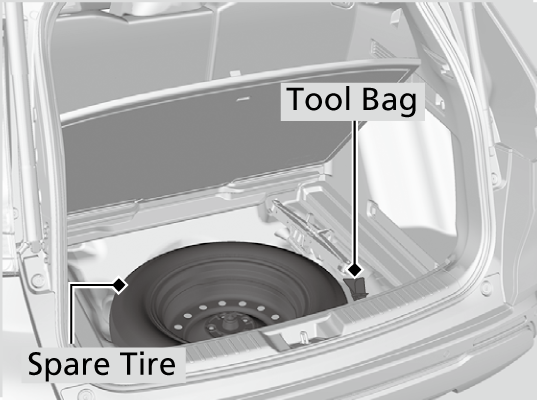
-
- Take the jack out of the spare tire area.
- Remove the jack by turning the jack’s end bracket to the left to loosen it.
- Unscrew the wing bolt, and remove the spacer cone. Then, remove the spare tire.
- Take the jack out of the spare tire area.
-
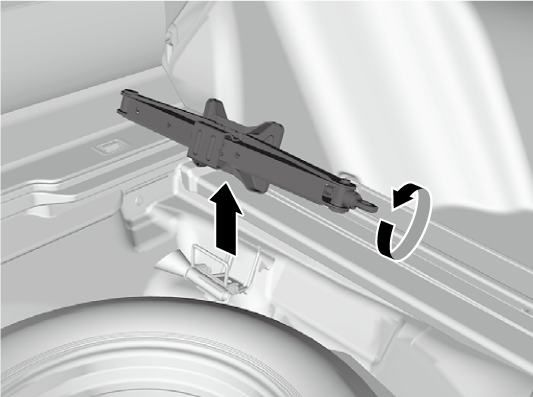
-
- Place a wheel block or rock in front and rear of the wheel diagonal to the flat tire.
-
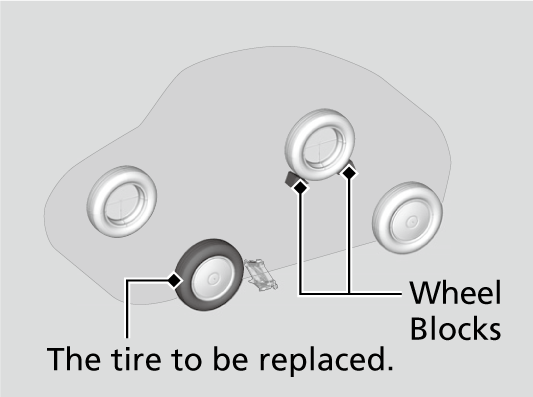
-
- Place the compact spare tire (wheel side up) under the vehicle body, near the tire that needs to be replaced.
-
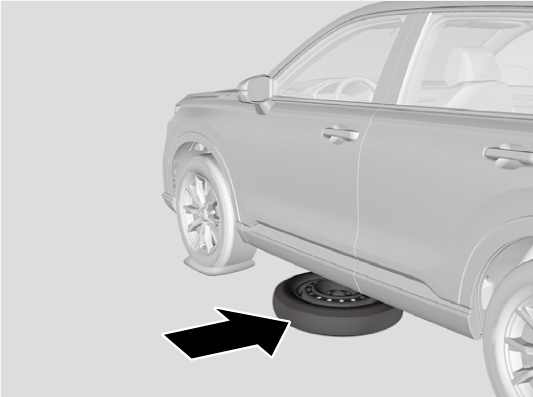
-
Models with wheel cover
- Put the flat tip of the jack handle bar into the edge of the wheel cover. Carefully pry the edge and remove the cover.
- Wrap a cloth around the flat tip of the jack handle bar to prevent scratches on the cover.
- Put the flat tip of the jack handle bar into the edge of the wheel cover. Carefully pry the edge and remove the cover.
-
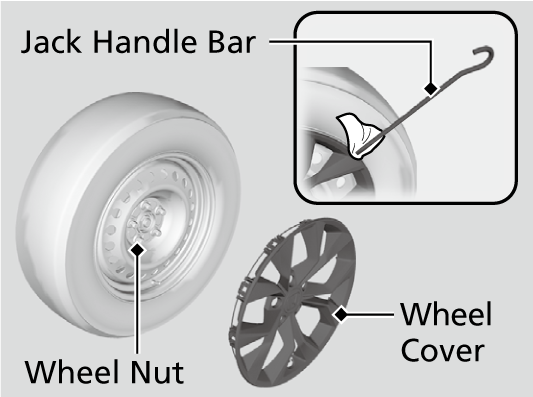
-
All models
- Loosen each wheel nut about one turn using the wheel nut wrench.
-
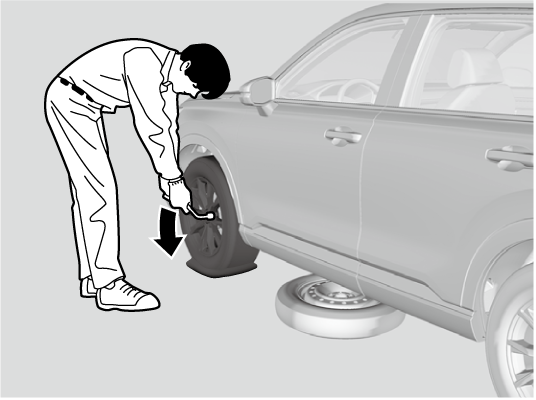
How to Set Up the Jack
-
- Place the jack under the jacking point closest to the tire to be changed.
-
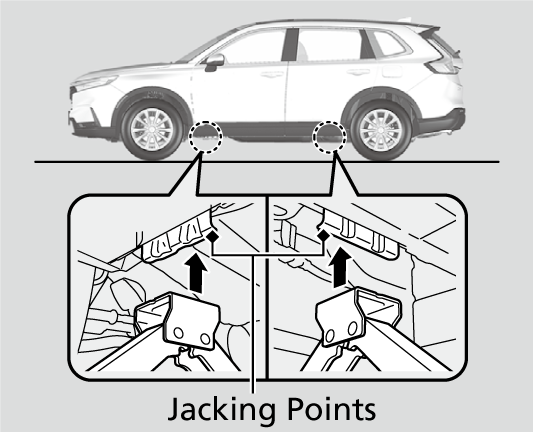
-
- Turn the end bracket clockwise as shown in the image until the top of the jack contacts the jacking point.
- Make sure that the jacking point tab is resting in the jack notch.
- Turn the end bracket clockwise as shown in the image until the top of the jack contacts the jacking point.
-

-
- Raise the vehicle, using the jack handle bar and the jack handle, until the tire is off the ground.
-
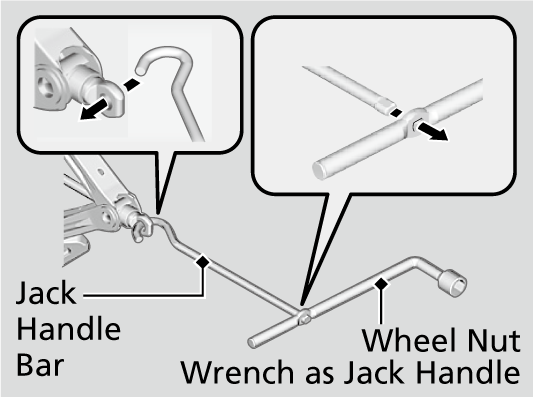
- WARNING
-
The vehicle can easily roll off the jack, seriously injuring anyone underneath.
Follow the directions for changing a tire exactly, and never get under the vehicle when it is supported only by the jack.
- Detail
-
Do not use the jack with people or luggage in the vehicle.Use the jack provided in your vehicle.
Other jacks may not support the weight (“load”) or may not fit the jacking point.
The following instructions must be followed to use the jack safely:- Do not use while the engine is running.
- Use only where the ground is firm and level.
- Use only at the jacking points.
- Do not get in the vehicle while using the jack.
- Do not put anything on top of or underneath the jack.
Loose items can fly around the interior in a crash and can seriously injure the occupants.Store the wheel, jack, and tools securely before driving.
Replacing the Flat Tire
-
- Remove the wheel nuts and flat tire.
-

-
- Wipe the mounting surfaces of the wheel with a clean cloth.
- Mount the compact spare tire.
- Screw the wheel nuts until they touch the lips around the mounting holes, then stop rotating.
-
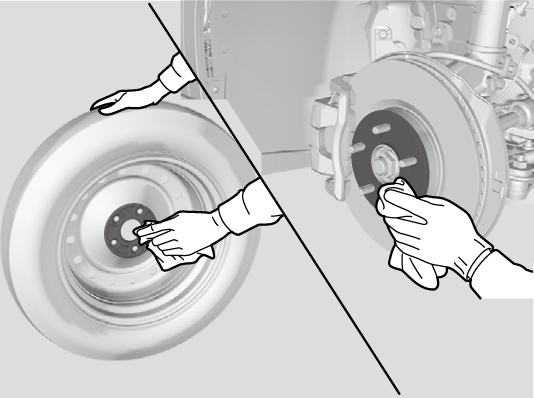
-
- Lower the vehicle and remove the jack. Tighten the wheel nuts in the order indicated in the image. Go around, tightening the nuts, two to three times in this order.Wheel nut torque:80 lbf∙ft (108 N∙m, 11 kgf∙m)
- Lower the vehicle and remove the jack. Tighten the wheel nuts in the order indicated in the image. Go around, tightening the nuts, two to three times in this order.
-
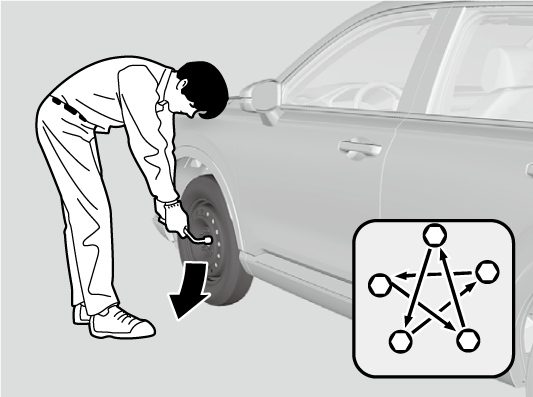
- Detail
-
Do not over tighten the wheel nuts by applying extra torque using your foot or a pipe.Models with wheel coverMake sure the wire support ring is hooked into the clips around the edge of the wheel cover.
Align the valve mark on the wheel cover to the tire valve on the wheel, then install the wheel cover.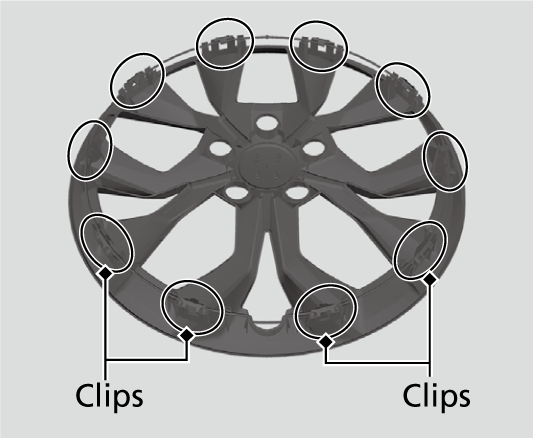
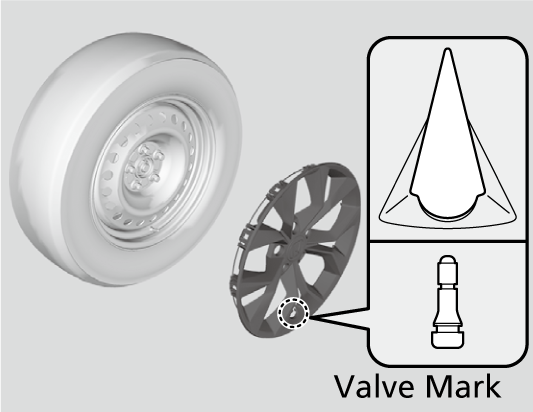 Models with wheel coverMake sure the wire support ring is on the outer side of the tire valve as shown.
Models with wheel coverMake sure the wire support ring is on the outer side of the tire valve as shown.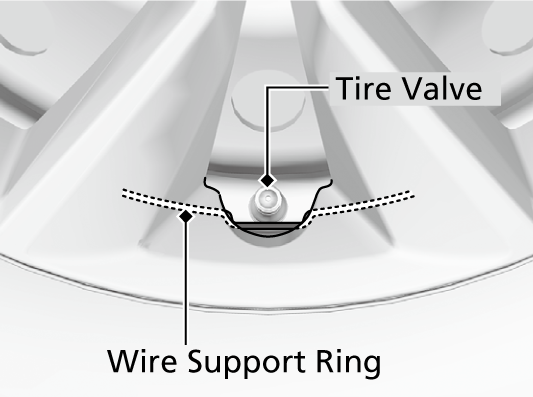
Storing the Flat Tire
-
Models with aluminum wheels
- Remove the center cap.
-
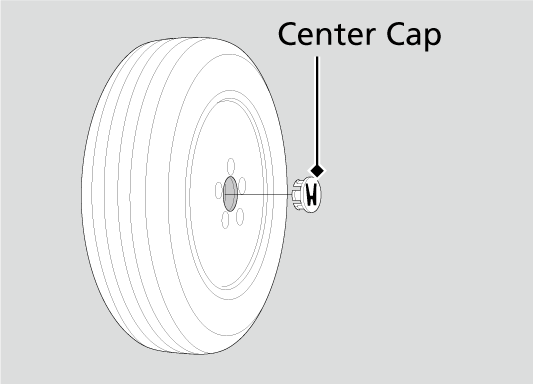
-
All models
- Place the flat tire face down in the spare tire well.
- Remove the spacer cone from the wing bolt, flip it over, and insert it back on the bolt. Secure the flat tire with the wing bolt.
- Securely store the wheel nut wrench and jack handle bar back in the tool bag. Store the bag in the cargo area.
- Store the jack in its holder. Turn the jack’s end bracket to lock it in place.
-
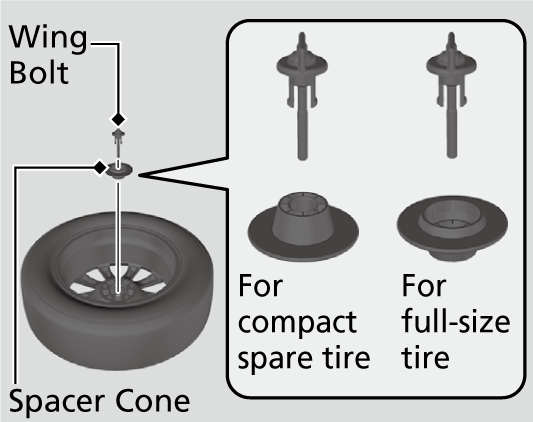
- WARNING
-
Loose items can fly around the interior in a crash and can seriously injure the occupants.
Store the wheel, jack, and tools securely before driving.
TPMS and the Compact Spare Tire
If you replace a flat tire with the spare tire, the low tire pressure/TPMS indicator comes on while you are driving. After driving for a few miles (kilometers), Tire pressure monitor system problem. Check tire pressure. See your dealer. will appear on the driver information interface and the indicator will start blinking for a short time and then stay on; however, this is normal and is no cause for concern.
Calibrate the TPMS when you replace the tire with a specified regular tire.
- Recommended topic(s)

